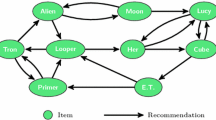Abstract
In order to be capable of exploiting context for pro-active information recommendation, agents need to extract and understand user activities based on their knowledge of the user interests. In this paper, we propose a novel approach for context-aware recommendation in browsing assistants based on the integration of user profiles, navigational patterns and contextual elements. In this approach, user profiles built using an unsupervised Web page clustering algorithm are used to characterize user ongoing activities and behavior patterns. Experimental evidence show that using longer-term interests to explain active browsing goals user assistance is effectively enhanced.
Similar content being viewed by others
Explore related subjects
Discover the latest articles, news and stories from top researchers in related subjects.References
Acharyya, S. and Ghosh, J., “Context-sensitive modelling of Web-surfing behaviour using concept trees,” in Proc. of the Fifth Int. Workshop on Knowledge Discovery in the Web (WEBKDD’2003), pp. 1–8, 2003.
Agrawal, R., Imielinski, T., and Swami, A., “Mining association rules between sets of items in large databases,” in Proc. of the 1993 ACM SIGMOD International Conf. on Management of Data, pp. 207–216, 1993.
Bauer, T. and Leake, D., “WordSieve: A method for real-time context extraction,” in Modeling and Using Context, Int. and Interdisciplinary Conf. vol. 2116 of LNCS, Springer, pp. 30–44, 2001.
Brown, P. and Jones, G., “Context-aware retrieval: Exploring a new environment for information retrieval and information filtering,” Personal and Ubiquitous Computing, 5, 4, pp. 253–263, 2001.
Budzik, J., Bradshaw, S., Fu, X., and Hammond, K., “Supporting on-line resource discovery in the context of ongoing tasks with proactive software assistants,” Int. Journal of Human Computer Studies, 56, 1, pp. 47–74, 2002.
Catledge, L. D. and Pitkow, J. E., “Characterizing browsing strategies in the World Wide Web,” Computer Networks and ISDN Systems, 27, 6, pp. 1065–1073, 1995.
Chen, M.-S., Park, J. S., and Yu, P., “Efficient data mining for path traversal patterns,” IEEE Transactions on Knowledge and Data Engineering, 10, 2, pp. 209–221, 1998.
Cooley, R., Mobasher, B., and Srivastava, J., “Grouping Web page references into transactions for mining World Wide Web browsing patterns,” in Proc. of the IEEE Knowledge and Data Engineering Exchange Workshop, pp. 2–9, 1997.
Cooley, R., Mobasher, B., and Srivastava, J., “Data preparation for mining World Wide Web browsing patterns,” Knowledge and Information Systems, 1, 1, pp. 5–32, 1999.
Eirinaki, M., Vazirgiannis, M., and Varlamis, I., “SEWeP: Using site semantics and a taxonomy to enhance the web personalization process,” in Proc. of the 9th ACM SIGKDD Int. Conf. on Knowledge Discovery and Data Mining (KDD’03), pp. 99–108, 2003.
Godoy, D. and Amandi, A., “A conceptual clustering approach for user profiling in personal information agents,” AI Communications, 19, 3, pp. 207–227, 2006.
Godoy, D. and Amandi, A., “Learning browsing patterns for context-aware recommendation,” in Artificial Intelligence in Theory and Practice, IFIP 19th World Computer Congress, vol. 217, Springer, pp. 61–70, 2006.
He, D. and Goker, A., “Detecting session boundaries from Web user logs,” in Proc. of the 22nd Annual Colloquium on IR Research, pp. 57–66, 2000.
Lieberman, H., Fry, C., and Weitzman, L., “Exploring the web with reconnaissance agents,” Communications of the ACM, 44, 8, pp. 69–75, 2001.
Michalski, R. S. and Stepp, R. E., “Learning from observation: Conceptual clustering,” in Machine Learning: An Artificial Intelligence Approach, Morgan Kaufmann, pp. 331–363, 1984.
Mobasher, B., Dai, H., Luo, T., and Nakagawa, M., “Discovery and evaluation of aggregate usage profiles for Web personalization,” Data Mining and Knowledge Discovery, 6, 1, pp. 61–82, 2002.
Oberle, D., Berendt, B., Hotho, A., and Gonzalez, J., “Conceptual user tracking,” in Web Intelligence, 1st International Atlantic Web Intelligence Conference, vol. 2663 of LNCS, Springer, pp. 155–164, 2003.
Perkowitz, M. and Etzioni, O., “Towards adaptive web sites: Conceptual framework and case study,” Artificial Intelligence, 118, 1-2, pp. 245–275, 2000.
Ruthven, I., “and this set of words represents the user’s context...,” in Workshop on Information Retrieval in Context at SIGIR 2004, pp. 10, 2004.
Sieg, A., Mobasher, B., and Burke, R., “Inferring user’s information context: Integrating user profiles and concept hierarchies,” in Proc. of the 2004 Meeting of the Int. Federation of Classification Societies, 2004.
Srikant, R. and Agrawal, R., “Mining generalized association rules,” in Proc. of the 21th Int. Conf. on Very Large Data Bases, pp. 407–419, 1995.
Author information
Authors and Affiliations
Corresponding author
About this article
Cite this article
Godoy, D., Amandi, A. Exploiting User Interests to Characterize Navigational Patterns in Web Browsing Assistance. New Gener. Comput. 26, 259–275 (2008). https://doi.org/10.1007/s00354-008-0044-x
Received:
Revised:
Published:
Issue Date:
DOI: https://doi.org/10.1007/s00354-008-0044-x




